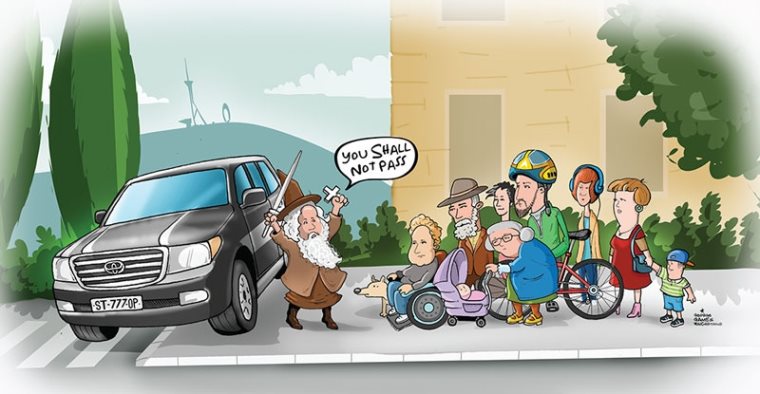AS CARS ZIP BY QUICKLY, Giorgi waits on the sidewalk in front of a zebra crossing where Pekini St. meets Tsintsadze St. The sun is setting, and people are getting ready for the Easter weekend. The hustle and bustle of the city is palpable, as many on street are carrying the traditional Paska (Easter bread) and red colored eggs. The leaves on the trees have finally turned green, making Tbilisi look like a friendly city again after the long grey winter months, and the air pollution from Tbilisi’s legion of cars feels less annoying as a result.
A white Mitsubishi Pajero slows down and puts on its turn-signal. The driver wants to park on the sidewalk. He lowers his window, sticks his head out, and asks Giorgi, who is still waiting patiently at the zebra stripe to cross the road, to move out of the way so he can park on the pavement.
But Giorgi is not having it. “Sir, there is no parking on this sidewalk, so I suggest you stop somewhere else,” Giorgi tells the driver.
The driver’s eyes rage with anger. He then sits back down, puts his hands and on the steering wheel, and hits the gas, driving straight into Giorgi.
The driver decided to deliberately drive into Giorgi because he was upset that Giorgi wouldn’t let him park on the sidewalk illegally. Just think about this for a second: the driver was angry that he couldn’t do something illegal, but felt entitled to do it, and so he decided that he had the right to physically hurt someone who was stopping him from this illegal act.
One illegal act begets another.
This is no isolated incident, and it fairly exemplifies the attitude of drivers in Tbilisi. It also shows how cars have taken over the city en mass.
However, the above situation merely exposes the emotional side of an unwalkable city. How much could Tbilisi gain if it were to become a walkable city, a transformation seen in recent years in New York, Bogota, and elswhere?
MOVING TOWARDS A WALKABLE CITY
After battling a long war with air pollution, Paris announced that from May on one Sunday a month, the French capital’s grandest boulevard – the Champs-Elysees – would now be car-free. In Belgium, Ghent’s entire city center is car-free – only public transport, taxis and permit-holders are allowed to drive there (at low speeds only). Strøget, Copenhagen has a large downtown car-free shopping area. In Groningen, the Netherlands, the city center has been pedestrianized for more than two decades now. Just recently New York prohibited cars on Times Square. And more cities every day are realizing the benefits of reducing the number of cars in their towns on a daily basis.
Giorgi Kankia, who was intentionally hit by a car, is not your average pedestrian. He is an urban planner and Chair of the Georgian pedestrian rights membership association Iare Pekhit. He explains to me that cities are slowly moving towards a more pedestrian-friendly approach worldwide.
“Planning cities on a human scale is at the core of modern urban planning principles, and examples from both developed and developing countries demonstrate that walking is one of the measures to be taken into account while building human-friendly cities,” he says.
SO, WHY IS THAT?
The health of the urban population and the walkability of an area have been clearly linked in a multitude of studies over the past years.
In Paris, the main concern is air pollution. And that’s for good reason.
“The total number of deaths due to HIV and malaria is 2.8 million per year,” says Professor Jos Lelieveld, from the Max Planck Institute for Chemistry in Germany. “That’s half a million less than the number of people who die from air pollution globally,” he notes.
And that number is predicted to grow even more. In Georgia, 79% of all air pollution comes from car exhaust alone. In addition to air pollution, a reduction in cases of obesity, diabetes, and heart attacks has been documented when an area becomes more walkable.
In Georgia, 40% of all deaths are caused by heart disease, making it the number one cause of death in Georgia. Consequently, heart disease is directly linked to the amount of physical activity one gets. As research shows, in places where you are unable to easily walk, the amount of physical activity you get significantly decreases. This is no less so the case in Georgia, where only 16% of the population gets two hours of physical activity a week.
According to recent research conducted in the United States, $1 billion dollars a day is spent on heart disease and stroke-related medical bills and lost productivity. Lost productivity is something which should not be underestimated, as the amount of work you are unable to do because of high blood pressure is very real.
In Georgia, as a result of the growing number of people with heart disease, healthcare spending has risen as well. Deloitte predicted that the healthcare spending per capita is expected to grow an average of 4.4% annually through 2017.
All this while cardiovascular disease is largely preventable. In fact, only 20% of cases of heart disease are inevitable.
Just imagine the amount of money the Georgian government could save if it would plan its cities more wisely.
BUT THAT’S NOT THE ONLY REASON
Studies show that cities that are more walkable not only improve the health of the people living there, walkability also has a positive impact on environmental, safety, economic, and social issues.
Irakli Zhvania, an MIT-trained urban planner, who has worked with the New York City Urban Planning Department, says that due to poor or no comprehensive urban planning in Tbilisi, public spaces ranging from sidewalks to green areas, are now disappearing.
“The street has become merely a space to move from one building to another, and even this has become very difficult today. There are many cases where pedestrians have been hit by cars on the sidewalks, or because they have been forced to walk into traffic lanes to pass,” Irakli explains.
According to research conducted by the World Health Organization to road-related mortality rates, Georgia has one of the highest rates of road traffic deaths, ranking 45th among 50 European and post-Soviet countries.
Jumpstart Georgia, a local NGO helping organizations advocate and communicate more effectively, showed in 2013 that one-third of all car accidents involve pedestrians, and that speeding is the number one cause of fatal accidents in Georgia.
SO, WHAT ABOUT THE ECONOMIC SIDE OF THINGS?
Walkable cities are more economically viable. In other words, by pedestrianizing urban areas, local businesses, real estate, and municipalities significantly increase their revenue. There is no research that contradicts this.
“Aside from it being a healthy activity, walking has important economic benefits as well – especially for businesses on the street level. For example, studies show that 33% of shopping trips in Copenhagen are done on foot, and they generate 23% of total revenue by mode of transport,” Giorgi Kankia tells me.
In Bristol, UK, the number of people shopping in an area that was pedestrianized increased by 20 to 40%. In London, making an area more walkable resulted in 40 to 55% more spending. In Washington, D.C., 44 new businesses were opened and 200 jobs were created after redesigning its urban landscape. A 300% increase in employment was documented after the redevelopment of the Temple Bar district in Dublin. These are just a handful of many examples that demonstrate the positive economic impact walkable cities have.
In New York, they approached the issue in a low-cost, easy-to-turn-around again manner, to see if pedestrianizing certain areas would be a success. And it was.
Janet Sadikh-Khan, Commissioner of the NYC Department of Transportation under the Bloomberg administration, explains in a TED talk the immense benefits it brought New York.
“In the three years since we’ve implemented the project [in a Brooklyn district], retail sales have increased 172 percent. That’s twice that of adjacent areas in the same neighborhood.”
She explains that when they cut-off Times Square temporarily to test the project, they were amazed at how fast it worked.
“We put out the orange barrels, and people just materialized immediately onto the street. It was like a Star Trek episode you know? They weren’t there before, and then zzzzzt! The people just arrived. Where they’d been, I don’t know, but they were there.”
The numbers don’t lie.
BUT WHERE DO ALL THE CARS GO?
In December, at an event organized by the pedestrian rights organization Iare Pekhit, Vasil Abuladze, Deputy Head of Tbilisi City Hall’s Transport Department, and Mikheil Maskhulia, Head of the Administrative Offence Proceedings and Legal Acts Expertise Department of Tbilisi’s municipality, were clear in their willingness to create a more pedestrian friendly city.
A prime example of this is the city’s plan to pedestrianize an area in the Plekhanovi district.
But in response to questions on what else would be done, they were equally clear: Tbilisi has a lot of cars, and roads need to be created to accommodate these cars. Tbilisi needs more roads.
A perfect example of the city’s road strategy can be seen in the recent decision to rebuild a road from Tbilisi’s most central square (Freedom Square), to the river embankment. The area was cut-off for cars in one direction after the previous government discovered an ancient wall under the asphalt after they started redevelopment of the neighborhood.
But both Irakli and Giorgi say that this train-of-thought is a common misconception in Georgia. More roads, lead to more cars, without exception.
“There is no city in the world that can have enough roads to accommodate all the cars. Theoretically this would mean living among multi-leveled highways and intersections with many lanes, which is impossible,” Irakli explains.
Giorgi agrees.
“One of the reasons Tbilisi is such a hostile environment for pedestrians is because of a myth that is widely spread throughout society – that limiting car traffic would make the city totally impassable.”
And not only.
Research shows that by creating both additional and wider roads, you invite more traffic, not less. One of the reasons, urban planner Wes Marshall explains, is that more people will choose to use their car because it is more comfortable than walking, cycling, or using public transportation.
“The joke is that adding lanes to cure congestion is like loosening your belt to cure obesity,” Wes writes.
BUT WHAT ABOUT THE COST?
In Bogota, a city of more than 9 million people, Mayor Enrique Peñalosa came up with a plan in 2000 to reduce the amount of cars in the city. First he restricted traffic during peak hours to reduce rush hour traffic by 40 percent, and then convinced the city council to increase the tax on gasoline. Half of the revenue generated by the increase was then poured into a bus system with special bus-lanes, making it faster and more comfortable to commute by bus instead of car.
In New York City, they created pedestrian areas using just a few buckets of paint and a handful of flower pots.
“Instead of waiting through years of planning studies and computer models to get something done, we’ve done it with paint and temporary materials,” Janet Sadikh-Khan says in her TED talk.
Another low-cost solution to make Tbilisi more pedestrian-friendly is to enforce the law. Eric Livny, Director of the International School of Economics at Tbilisi State University (ISET) explains that this worked in Moscow, Yerevan, and other cities around the world.
“[All] Georgia has to do is implement an obvious and very simple policy solution – introduce tougher regulations, higher fines and stricter enforcement,” he says.
TBILISI: A FUTURE WALKABLE CITY?
The benefits of making Tbilisi walkable are extensive. Not only does it reduce heart disease, obesity, diabetes, air pollution-related health issues, and (fatal) car accidents, it also brings with it extensive economic revenue to the city and local business owners.
The costs of making Tbilisi more walkable are negligible. With just a bucket of paint, by enforcing the law, and by making public transportation faster and more comfortable than taking a car, immediate results will benefit the city on all levels.
“I think that the lesson that we have learned from New York is that it’s possible to change your streets quickly. It’s not expensive, it can provide immediate benefits, and it can be quite popular too. You just need to reimagine your streets. They’re hidden in plain sight,” said Janet Sadikh-Khan.
Illustration: Giorgi Gamezardashvili

















